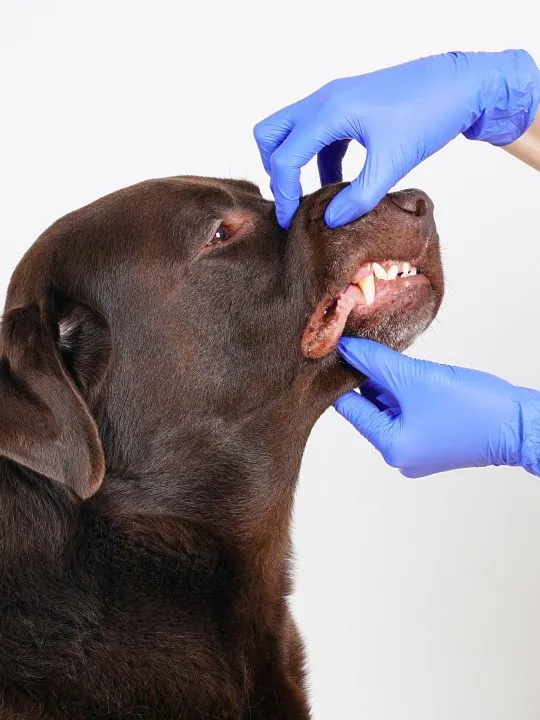If your dog is coming up shy of consuming the amount of water that his body needs, there’s probably no need to worry.
Unless they have a serious medical condition most likely they are still staying hydrated.
Dogs become dehydrated when they aren’t drinking enough water or if they are losing more water than they are taking in or when they are not taking in enough water.
This can often be due to long bouts with diarrhea or vomiting, overheating and diseases such as kidney disease, cancer, and unregulated diabetic dogs.
A dog doesn’t just lose water when they are dehydrated they also lose electrolytes which include minerals such as sodium, chloride, and potassium which is why it’s super important to seek medical attention if you suspect that your dog is dehydrated.
Causes of Dehydration In Dogs and Puppies
There can be many reasons why a dog might become dehydrated.
Some of the more common reasons for dehydration in dogs are:
- Vomiting or diarrhea
- Medical conditions such as diabetes, kidney disease or intestinal conditions.
- Parasites
- Heatstroke
- Excessive panting
4 Easy Ways To Check If Your Dog Is Dehydrated
If you suspect that your dog might be dehydrated there are some super easy ways that you can check:
- Skin test
- Gum check
- Eye Check
- Observation
How To Do The Skin Tent Test On Your Dog
The skin tent test is the easiest way to check if a dog is dehydrated.
To check for dehydration on the skin simply lift the skin between the shoulder blades to form a tent.
Now drop it.

A general rule of thumb is that with a hydrated dog, the skin will go back into place almost immediately. In a dehydrated dog, the skin will slowly go back in place or stay tented.
The longer it takes for the skin to go back into the place the more dehydrated the dog may be.
This is the first thing we would do at the vet if we were examining a dog that was vomiting or had chronic diarrhea.
How To Check Your Dog’s Gums For Dehydration
While the skin elasticity test is a great and quick test it can be difficult to do with some dogs so you can also check hydration by checking their gums.
Simply lift up their upper lip and touch with your finger.
A hydrated dog should have a wet, glossy look to their gums and they will feel wet.
The gum of a dehydrated dog will look dull and feel sticky or tacky to the touch.

While you’re touching the gums check the capillary refill time.
A dog’s gums are normally pink and when you press on them they will turn white for a second and then back to the original pink color.
With a dog that is dehydrated the color will stay white longer.
A longer refill time could mean that the dog is dehydrated.
How To Check Your Dog’s Eye For Dehydration
A dog that is very dehydrated may have a sunken eye appearance.
Remember a dog’s body is made up of about 80% water and dehydration causes shrinkage of all the major tissues, including that fat pad around the eye.

This also affects the water content within the eyeball.
So when a dog is extremely dehydrated, the fat pads behind the eye shrink and the eyeball will dehydrate causing the eyeball to sink.
Observing Your Dog’s Habits
Observing your dog’s normal habits can tell a lot about their hydration.
Dehydrated dogs will often be more tired than normal, urinate less, have a dark color and strong odor to their urine, have trouble walking, refuse to eat, not be interested in playing, pant heavily and have a general overall appearance of feeling crummy.
If you decide that your dog is dehydrated the best thing to do would be to contact your veterinarian.
What To Do If Your Dog Is Dehydrated
If you suspect that your dog is dehydrated you should reach out to your veterinarian.
While they are easy ways that you can try to get your dog to drink more water, it’s always best to have your dog seen by your vet.
Your vet will be able to offer your dog fluids, either under the skin or IV fluids to help hydrate them faster.
You’ll also want to address any medical conditions that could be contributed to their dehydration.

Preventing Dehydration In Dogs and Puppies
While dehydration in dogs can sometimes not be avoidable due to illnesses that can only be treated by a veterinarian there are ways you can try to avoid it in otherwise healthy dogs.
If you have a senior dog make sure that they have safe access to water or bring them their bowl several times a day.
Offer plenty of fresh and clean water.
Make sure you have water bowls placed throughout the house and outside that your dog has access to.
Change the water several times a day especially during the warmer months.
Humans don’t like to drink warm stale water that has been sitting out all day and neither do dogs.
Wash the bowls.
Water bowls can form a fil on them that should be washed away on a daily basis.
If your dog seems interested in drinking water but won’t, you should have them examined by a veterinarian.